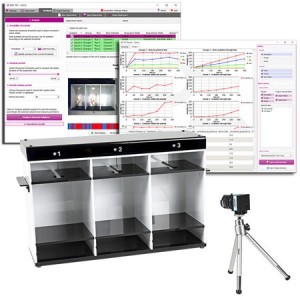Authors
Ö. Devrim Can, Ü. Demir Özkay, U. İrfan Üçel.
Lab
Anadolu University, Eskişehir, Turkey.
Journal
European Journal of Pharmacology
Abstract
The present study was designed to investigate the putative effect of vitexin, a flavone C–glucoside present in some drugs, medicinal plants and nutraceuticals, on the central nervous system. Vitexin (10–30 mg/kg) did not show significant alterations in the behaviour of mice tested in hole-board, plus-maze or activity cage tests. However, immobility time of the mice significantly reduced by vitexin administrations in both the tail-suspension and modified forced swimming tests. The anti-immobility effect of vitexin in the tail-suspension test was reversed with α-methyl-para-tyrosine methyl ester (AMPT, an inhibitor of catecholamine synthesis, 100 mg/kg, i.p.), yohimbine (an α2-adrenoceptor antagonist, 1 mg/kg, i.p.), NAN 190 (a 5-HT1A antagonist, 0.5 mg/kg, i.p.), SCH 23390 (a dopamine D1 antagonist, 0.05 mg/kg, s.c.) and sulpiride (a dopamine D2/D3 antagonist, 50 mg/kg, i.p.). The same effect was not reversed, however, by p-chlorophenylalanine methyl ester (PCPA; an inhibitor of serotonin synthesis 100 mg/kg, i.p., administered for 4 consecutive days), ketanserin (a 5-HT2A/2C antagonist, 1–4 mg/kg, i.p.), ondansetron (a 5-HT3 antagonist, 0.1–0.4 mg/kg, i.p.), prazosin (an α1-adrenoceptor antagonist, 1–4 mg/kg, i.p.), or propranolol (a non-selective β-adrenoceptor antagonist, 5–20 mg/kg, i.p.). These results suggest that the anti-depressant-like effect of vitexin is mediated through an increase in catecholamine levels in the synaptic cleft as well as through interactions with the serotonergic 5-HT1A, noradrenergic α2, and dopaminergic D1, D2, and D3 receptors. To our knowledge, this is the first study to show findings that indicate an anti-depressant-like effect of vitexin and its underlying mechanisms.
BIOSEB Instruments Used
Tail Suspension Test - Wireless (BIO-TST5)
Source :
http://www.sciencedirect.com/science/article/pii/S0014299912008631

 Pain - Thermal Allodynia / Hyperalgesia
Pain - Thermal Allodynia / Hyperalgesia Pain - Spontaneous Pain - Postural Deficit
Pain - Spontaneous Pain - Postural Deficit Pain - Mechanical Allodynia / Hyperalgesia
Pain - Mechanical Allodynia / Hyperalgesia Learning/Memory - Attention - Addiction
Learning/Memory - Attention - Addiction Physiology & Respiratory Research
Physiology & Respiratory Research











![Dynamic Weight Bearing 2.0 – Postural Module [Add-on]](https://bioseb.com/733-home_default/dynamic-weight-bearing-20-add-on-postural-module.jpg)
























 Pain
Pain Central Nervous System (CNS)
Central Nervous System (CNS) Neurodegeneration
Neurodegeneration Sensory system
Sensory system Motor control
Motor control Mood Disorders
Mood Disorders Other disorders
Other disorders Muscular system
Muscular system Joints
Joints Metabolism
Metabolism Cross-disciplinary subjects
Cross-disciplinary subjects CONFERENCES & MEETINGS
CONFERENCES & MEETINGS 